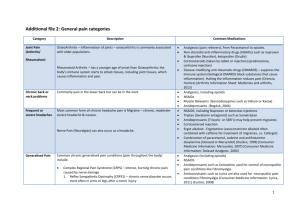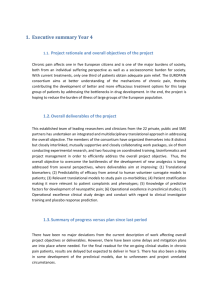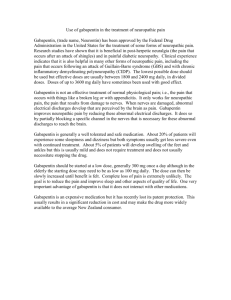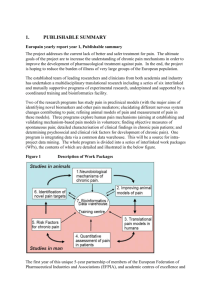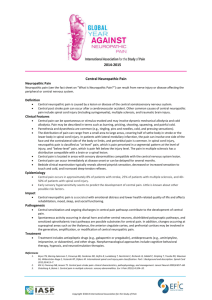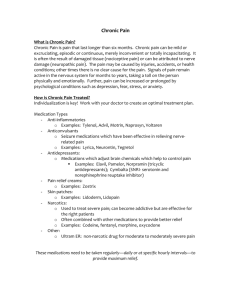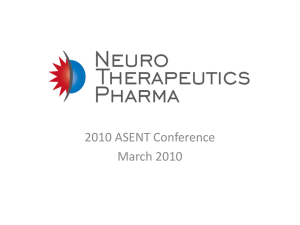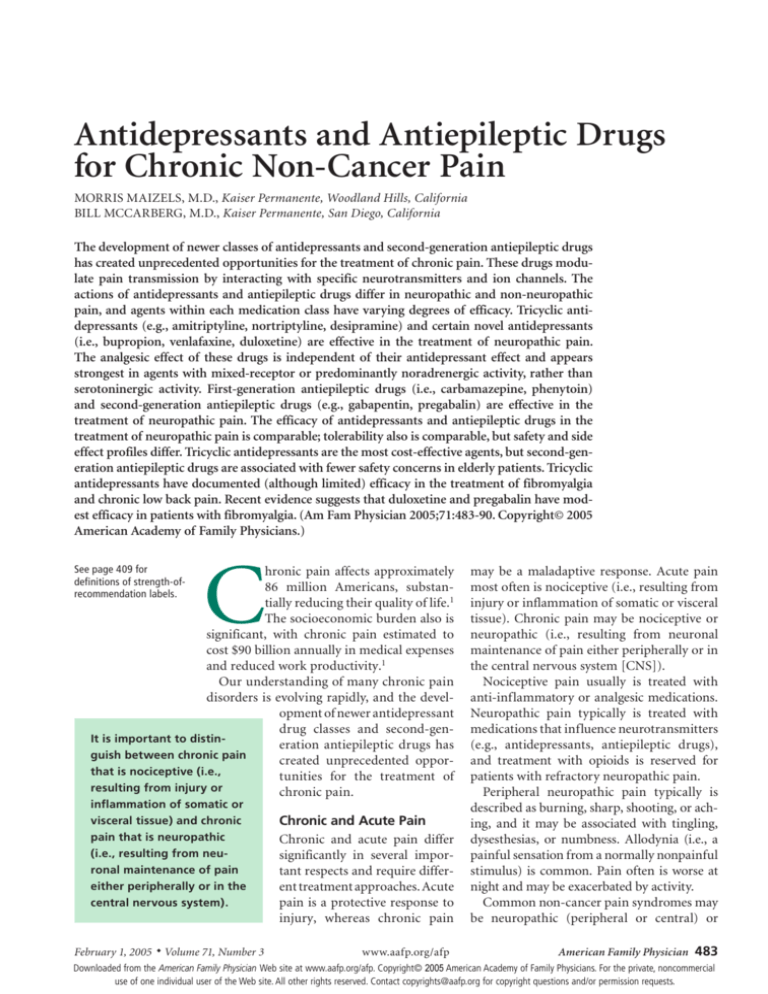
Antidepressants and Antiepileptic Drugs
for Chronic Non-Cancer Pain
MORRIS MAIZELS, M.D., Kaiser Permanente, Woodland Hills, California
BILL MCCARBERG, M.D., Kaiser Permanente, San Diego, California
The development of newer classes of antidepressants and second-generation antiepileptic drugs
has created unprecedented opportunities for the treatment of chronic pain. These drugs modulate pain transmission by interacting with specific neurotransmitters and ion channels. The
actions of antidepressants and antiepileptic drugs differ in neuropathic and non-neuropathic
pain, and agents within each medication class have varying degrees of efficacy. Tricyclic antidepressants (e.g., amitriptyline, nortriptyline, desipramine) and certain novel antidepressants
(i.e., bupropion, venlafaxine, duloxetine) are effective in the treatment of neuropathic pain.
The analgesic effect of these drugs is independent of their antidepressant effect and appears
strongest in agents with mixed-receptor or predominantly noradrenergic activity, rather than
serotoninergic activity. First-generation antiepileptic drugs (i.e., carbamazepine, phenytoin)
and second-generation antiepileptic drugs (e.g., gabapentin, pregabalin) are effective in the
treatment of neuropathic pain. The efficacy of antidepressants and antiepileptic drugs in the
treatment of neuropathic pain is comparable; tolerability also is comparable, but safety and side
effect profiles differ. Tricyclic antidepressants are the most cost-effective agents, but second-generation antiepileptic drugs are associated with fewer safety concerns in elderly patients. Tricyclic
antidepressants have documented (although limited) efficacy in the treatment of fibromyalgia
and chronic low back pain. Recent evidence suggests that duloxetine and pregabalin have modest efficacy in patients with fibromyalgia. (Am Fam Physician 2005;71:483-90. Copyright© 2005
American Academy of Family Physicians.)
See page 409 for
definitions of strength-ofrecommendation labels.
C
hronic pain affects approximately
86 million Americans, substantially reducing their quality of life.1
The socioeconomic burden also is
significant, with chronic pain estimated to
cost $90 billion annually in medical expenses
and reduced work productivity.1
Our understanding of many chronic pain
disorders is evolving rapidly, and the development of newer antidepressant
drug classes and second-genIt is important to distineration antiepileptic drugs has
guish between chronic pain
created unprecedented opporthat is nociceptive (i.e.,
tunities for the treatment of
resulting from injury or
chronic pain.
inflammation of somatic or
visceral tissue) and chronic
pain that is neuropathic
(i.e., resulting from neuronal maintenance of pain
either peripherally or in the
central nervous system).
February 1, 2005
◆
Volume 71, Number 3
Chronic and Acute Pain
Chronic and acute pain differ
significantly in several important respects and require different treatment approaches. Acute
pain is a protective response to
injury, whereas chronic pain
www.aafp.org/afp
may be a maladaptive response. Acute pain
most often is nociceptive (i.e., resulting from
injury or inflammation of somatic or visceral
tissue). Chronic pain may be nociceptive or
neuropathic (i.e., resulting from neuronal
maintenance of pain either peripherally or in
the central nervous system [CNS]).
Nociceptive pain usually is treated with
anti-inflammatory or analgesic medications.
Neuropathic pain typically is treated with
medications that influence neurotransmitters
(e.g., antidepressants, antiepileptic drugs),
and treatment with opioids is reserved for
patients with refractory neuropathic pain.
Peripheral neuropathic pain typically is
described as burning, sharp, shooting, or aching, and it may be associated with tingling,
dysesthesias, or numbness. Allodynia (i.e., a
painful sensation from a normally nonpainful
stimulus) is common. Pain often is worse at
night and may be exacerbated by activity.
Common non-cancer pain syndromes may
be neuropathic (peripheral or central) or
American Family Physician 483
Downloaded from the American Family Physician Web site at www.aafp.org/afp. Copyright© 2005 American Academy of Family Physicians. For the private, noncommercial
use of one individual user of the Web site. All other rights reserved. Contact copyrights@aafp.org for copyright questions and/or permission requests.
Strength of Recommendations
Key clinical recommendation
Label
References
Tricyclic antidepressants may be used for treatment of chronic neuropathic
and non-neuropathic pain syndromes.
Tricyclic antidepressants are more effective than SSRIs in the treatment of
neuropathic pain syndromes. An estimated 2.6 patients must be treated
with tricyclic antidepressants and 6.7 patients with SSRIs to have one
patient with more than 50 percent pain relief.
Serotoninergic antidepressants and currently approved antiepileptic drugs
have little documented efficacy and therefore should not be used as
first-line medications in the treatment of non-neuropathic pain.
A
5, 8, 11, 21
B
6, 14
B
7, 8, 30-33
SSRIs = selective serotonin reuptake inhibitors.
A = consistent, good-quality patient-oriented evidence; B = inconsistent or limited-quality patient-oriented evidence;
C = consensus, disease-oriented evidence, usual practice, opinion, or case series. See page 409 for more information.
non-neuropathic (Table 1).2 It is likely that
both peripheral and central mechanisms contribute to the persistence of most types of
neuropathic pain. Neuropathic pain also may
coexist with non-neuropathic pain (e.g., in
some patients with chronic low back pain).
Mechanism of Action of
Antidepressants and Antiepileptic
Drugs in Pain Syndromes
Transmission of painful stimuli through the
spinal column and CNS is modulated by
excitatory and inhibitory neurotransmitters,
as well as actions at sodium and calcium
channels. Norepinephrine and serotonin
may be excitatory or inhibitory, but they are
functionally inhibitory on pain transmission;
glutamate is the other important excitatory
neurotransmitter. The most important inhibitory neurotransmitter is -aminobutyric acid
(GABA). Antidepressants and antiepileptic
drugs are thought to relieve neuropathic pain
through interaction with specific neurotransmitters and ion channels (Table 2).3
TRICYCLIC ANTIDEPRESSANTS
TABLE 1
Common Non-Cancer Pain Syndromes
Peripheral
neuropathic pain
Central neuropathic
pain
Non-neuropathic
pain*
Complex regional pain
syndrome
Human immunodeficiency
virus sensory neuropathy
Idiopathic peripheral
neuropathy
Infection
Metabolic disorders
Alcohol and other toxins
Diabetic neuropathy
Nutritional deficiencies
Nerve compression or
entrapment
Phantom limb pain
Postherpetic neuralgia
Trigeminal neuralgia
Multiple sclerosis
Myelopathies
Parkinson’s disease
Poststroke pain
Arthritis
Inflammatory
arthritis
Osteoarthritis
Chronic low back
pain
Chronic neck pain
Fibromyalgia
Post-traumatic
pain
*—Elements of neuropathic pain may be superimposed on the underlying disorder
Information from reference 2..
484 American Family Physician
www.aafp.org/afp
Tricyclic antidepressants are thought to
affect pain transmission in the spinal cord
by inhibiting the reuptake of norepinephrine and serotonin, both of which influence descending pain pathways. In addition,
histamine H1-receptor affinity (associated
with sedation) may be correlated with the
analgesic effect of antidepressants. Amitriptyline (Elavil) also has an analgesic effect in
patients with acute pain.4
Tricyclic antidepressants may be categorized as secondary or tertiary amines.
Secondary amines such as nortriptyline
(Pamelor) and desipramine (Norpramin)
show relatively selective inhibition of norepinephrine reuptake. Tertiary amines such
as amitriptyline and imipramine (Tofranil)
show more balanced inhibition of norepinephrine and serotonin, but they also have
greater anticholinergic side effects.
The novel antidepressants venlafaxine
(Effexor) and duloxetine (Cymbalta) have
balanced inhibition of serotonin and norepinephrine reuptake without blockade of other
Volume 71, Number 3
◆
February 1, 2005
Chronic Pain
neuroreceptors that are responsible for typical tricyclic side effects. The mechanism of
action of bupropion (Wellbutrin) is uncertain
but involves blockade of dopamine uptake.
ANTIEPILEPTIC DRUGS
Antiepileptic drugs act at several sites that
may be relevant to pain, but the precise
mechanism of their analgesic effect remains
unclear. These agents are thought to limit
neuronal excitation and enhance inhibition.
Relevant sites of action include voltagegated ion channels (i.e., sodium and calcium channels), ligand-gated ion channels,
the excitatory receptors for glutamate and
N-methyl-D-aspartate, and the inhibitory
receptors for GABA and glycine (Table 2).3
Antiepileptic drugs may be categorized as
first or second generation. The second-generation agents are better tolerated, cause less
sedation, and have fewer CNS side effects.
Clinical Efficacy
The efficacy of antidepressants and antiepileptic drugs varies dramatically in neuropathic and non-neuropathic pain syndromes.
Specific agents within each medication class
can vary in effectiveness. Table 3 lists typical
dosages and side effects of medications commonly used to treat chronic pain. Table 44-19
reviews the levels of evidence for these agents.
NEUROPATHIC PAIN
Antidepressants. Meta-analyses5,6 have confirmed the efficacy of tricyclic antidepressants
in the treatment of neuropathic pain. Nontricyclic antidepressants show variable degrees of
efficacy in patients with neuropathic pain.
Antidepressants with mixed-receptor or noradrenergic activity appear to have the greatest
analgesic effect in patients with neuropathic
pain. Predominantly serotoninergic drugs,
such as selective serotonin reuptake inhibitors (SSRIs), often are ineffective in treating
chronic pain.5,20 Amitriptyline and its metabolite nortriptyline have the best documented
efficacy in the treatment of neuropathic and
non-neuropathic pain syndromes.4 The novel
antidepressants bupropion,10 venlafaxine,11
and duloxetine12 also have proved effective in
patients with neuropathic pain.
February 1, 2005
◆
Volume 71, Number 3
The efficacy of tricyclic antiNociceptive pain usually is
depressants in the treatment of
treated with anti-inflamneuropathic pain appears to be
matory or analgesic
independent of their antidepresmedications, whereas neusant effect,21 and patients with
pain but no depression respond
ropathic pain typically is
to these agents. Although pain
treated with antidepresreduction occurs at dosages
sants or antiepileptic drugs.
lower than those typically used to
treat depression, a dose response
between 25 and 100 mg has been noted.22
Some experts recommend documenting a
therapeutic level of a tricyclic antidepressant
before concluding that the drug is clinically
ineffective in a patient with chronic pain.
Antiepileptic Drugs. Specific antiepileptic drugs are effective in the treatment of
patients with neuropathic pain.14 Of the firstgeneration agents, carbamazepine (Tegretol)
is indicated for the treatment of trigeminal
neuralgia. Carbamazepine also has shown
modest efficacy in trials involving patients
with diabetic neuropathy or postherpetic
neuralgia.14 Phenytoin (Dilantin) is used
infrequently to treat chronic pain.
Of the second-generation antiepileptic
drugs, gabapentin (Neurontin) has the best
TABLE 2
Suggested Mechanisms of Action for Antidepressants
and Antiepileptic Drugs Used to Treat Chronic Pain
Mechanism of action
Drugs
Inhibition of
norepinephrine
reuptake
Inhibition of
norepinephrine and
serotonin reuptake
Tricyclic antidepressants (secondary amines):
desipramine (Norpramin), nortriptyline
(Pamelor)
Tricyclic antidepressants (tertiary amines):
amitriptyline (Elavil), imipramine (Tofranil)
Novel antidepressants: venlafaxine (Effexor),
duloxetine (Cymbalta)
Cyclobenzaprine (Flexeril)
Antiepileptic drugs: carbamazepine (Tegretol),
gabapentin (Neurontin), lamotrigine (Lamictal)
Antiepileptic drugs: gabapentin, pregabalin
(Lyrica)*
Antiepileptic drug: carbamazepine
Spasmolytic drug: baclofen (Lioresal)
Blockade of sodium
channel
Blockade of calcium
channel
Enhancement of
-aminobutyric acid
*—Investigational drug (approval pending from U.S. Food and Drug Administration).
Adapted with permission from Ross EL. The evolving role of antiepileptic drugs in treating neuropathic pain. Neurology 2002;55(5 suppl 1):S42.
www.aafp.org/afp
American Family Physician 485
TABLE 3
Antidepressants and Antiepileptic Drugs Used in Chronic Pain Syndromes
Drug
Dosage
Side effects, contraindications, and comments
Antidepressants
Tricyclic antidepressants
—
Side effects: dry mouth, constipation, urinary
retention, sedation, weight gain
Contraindications: cardiac conduction
abnormalities, recent cardiac events,
narrow-angle glaucoma
Tertiary amines have greater anticholinergic
side effects; therefore, these agents should
not be used in elderly patients.
Secondary amines have fewer anticholinergic
side effects.
Amitriptyline (Elavil),*
imipramine (Tofranil)*
Desipramine (Norpramin),*
nortriptyline (Pamelor)*
Selective serotonin
reuptake inhibitors
Fluoxetine (Prozac),*
paroxetine (Paxil)*
Novel antidepressants
Bupropion (Wellbutrin)*
Venlafaxine (Effexor)*
Duloxetine (Cymbalta)*
Antiepileptic drugs
First-generation agents
Carbamazepine (Tegretol)
Phenytoin (Dilantin)*
Second-generation agents
Gabapentin (Neurontin)
Pregabalin (Lyrica)
Lamotrigine (Lamictal)*
10 to 25 mg at bedtime; increase by 10 to
25 mg per week up to 75 to 150 mg at
bedtime or a therapeutic drug level.
25 mg in the morning or at bedtime;
increase by 25 mg per week up to 150 mg
per day or a therapeutic drug level.
10 to 20 mg per day; up to 80 mg per day
for fibromyalgia.
Side effects: nausea, sedation, decreased libido,
sexual dysfunction, headache, weight gain
Efficacy in pain syndromes is relatively poor.
100 mg per day; increase by 100 mg per
week up to 200 mg twice daily (400 mg
per day).
37.5 mg per day; increase by 37.5 mg per
week up to 300 mg per day.
Side effects: anxiety, insomnia or sedation,
weight loss, seizures (at dosages above
450 mg per day)
Side effects: headache, nausea, sweating,
sedation, hypertension, seizures
Serotoninergic properties in dosages below
150 mg per day; mixed serotoninergic and
noradrenergic properties in dosages above
150 mg per day
Side effects: nausea, dry mouth, constipation,
dizziness, insomnia
20 to 60 mg per day taken once or twice
daily in divided doses (for depression);
60 mg twice daily for fibromyalgia
200 mg per day; increase by 200 mg per
week up to 400 mg three times daily
(1,200 mg per day).
100 mg at bedtime; increase weekly up to
500 mg at bedtime.
Side effects: dizziness, diplopia, nausea
Treatment can result in aplastic anemia.
100 to 300 mg at bedtime; increase by 100
mg every 3 days up to 1,800 to 3,600 mg
per day taken in divided doses three times
daily.
150 mg at bedtime for diabetic neuropathy;
300 mg twice daily for postherpetic
neuralgia.
50 mg per day; increase by 50 mg every
2 weeks up to 400 mg per day.
Side effects: drowsiness, dizziness, fatigue,
nausea, sedation, weight gain
Side effects: dizziness, ataxia, slurred speech,
confusion, nausea, rash
Treatment can result in blood dyscrasias and
hepatotoxicity.
Side effects: drowsiness, dizziness, fatigue,
nausea, sedation, weight gain
Side effects: dizziness, constipation, nausea;
rarely, life-threatening rashes
*—Not approved by the U.S. Food and Drug Administration for treatment of neuropathic pain.
486 American Family Physician
www.aafp.org/afp
Volume 71, Number 3
◆
February 1, 2005
Chronic Pain
TABLE 4
Study-Quality Ratings for Antidepressants and Antiepileptic Drugs
in Chronic Pain Syndromes
Neuropathic pain
Trigeminal
neuralgia
Drug
Antidepressants
Amitriptyline (Elavil) 4-8
Non-neuropathic pain
Diabetic
neuropathy or
postherpetic
neuralgia
Fibromyalgia
Low back or
other pain
1
1
2
Fluoxetine (Prozac) 9
3
Bupropion (Wellbutrin)10
2
11
Venlafaxine (Effexor)
2
Duloxetine (Cymbalta)12,13
1
Antiepileptics
First generation
Carbamazepine (Tegretol)14
Phenytoin (Dilantin)14
1
3
3
Second generation
Gabapentin (Neurontin)15,16
Lamotrigine (Lamictal)17*
1
1
3
Pregabalin (Lyrica)18,19†
2
2
1 = good-quality patient-oriented evidence; 2 = limited-quality patient-oriented evidence; 3 = other evidence. See page
0000 for more information on ratings.
*—Efficacy of lamotrigine as an adjunct to carbamazepine or phenytoin.
†—Investigational drug (approval pending from U.S. Food and Drug Administration).
Information from references 4 through 19.
documented efficacy in the treatment of neuropathic pain. Gabapentin has been proved
superior to placebo in patients with painful
diabetic neuropathy15 or postherpetic neuralgia.16 In these trials,15,16 effective dosages have
ranged from 2,400 to 3,600 mg per day.
One study23 of patients with painful diabetic neuropathy found no significant effect
for gabapentin in a dosage of 900 mg per day.
The efficacy of this drug in other pain syndromes that may have a neuropathic component (e.g., persistent postoperative pain) has
been of borderline statistical significance.24
The investigational drug pregabalin (Lyrica)
has documented efficacy in the treatment of
diabetic neuropathy18 and postherpetic neuralgia.19 Approval of pregabalin by the U.S.
Food and Drug Administration is pending.
Lamotrigine (Lamictal) has been proved
modestly effective in patients with trigemiFebruary 1, 2005
◆
Volume 71, Number 3
nal neuralgia,17 neuropathy associated with
human immunodeficiency virus infection,25
and poststroke pain.26 The drug is ineffective in patients with unspecified refractory
neuropathic pain.27 The use of lamotrigine is
limited by potentially life-threatening rashes.
Comparative Efficacies. Antidepressants and
antiepileptic drugs have comparable efficacy
in patients with neuropathic pain. However,
the drug classes (and individual agents within
each class) differ in safety, tolerability, and side effect profiles.28
Second-generation antiIn a meta-analysis28 of triepileptic
drugs are better
als of antidepressants and antitolerated than first-genepileptic drugs in patients with
eration agents, cause less
neuropathic pain, the estimated
sedation, and have fewer
number needed to treat for sigcentral nervous system
nificant reduction of pain was
2.6 with tricyclic antidepresside effects.
sants, 6.7 with SSRIs, 2.5 with
www.aafp.org/afp
American Family Physician 487
sodium channel–blocking antiepileptic
drugs (i.e., phenytoin and carbamazepine),
and 4.1 with gabapentin. Another metaanalysis5 found no significant difference
between antidepressants and antiepileptic
drugs in the reduction of neuropathic pain.
A small randomized, double-blind, controlled trial29 of gabapentin and amitriptyline in patients with diabetic neuropathy
found that both agents were effective, with
no significant differences. Tolerability also
was comparable.
NON-NEUROPATHIC PAIN
The efficacy of tricyclic antidepressants has
been documented in a variety of non-neuropathic pain syndromes. Most other antidepressants and most antiepileptic drugs
have little or no documented efficacy in the
treatment of non-neuropathic pain.
Fibromyalgia. Analysis of controlled trials
on the treatment of fibromyalgia is limited
by differences in outcome measures, inconsistent reporting of associated depression,
and conflicting results.30 A meta-analysis31
found that antidepressants were mildly beneficial in reducing pain severity and improving sleep and overall well-being, and mildly
effective in reducing fatigue; treatment with
these agents also showed a trend for a beneficial effect on tender points.
In one study,32 30 to 47 percent of patients
The Authors
MORRIS MAIZELS, M.D., is a member of the Department of Family Medicine at
Kaiser Permanente, Woodland Hills, Calif., as well as founder and director of the
Woodland Hills Headache Clinic. Dr. Maizels received his medical degree from
the University of Washington School of Medicine, Seattle, and completed residency training at the Antelope Valley Family Practice Residency of the University
of California, Los Angeles. Dr. Maizels is a member of the board of directors of
the American Headache Society and an associate editor of Headache.
BILL MCCARBERG, M.D., is founder of the Chronic Pain Management Program
for Kaiser Permanente, San Diego, and assistant clinical professor in the
Department of Family Practice at the University of California, San Diego, School
of Medicine. Dr. McCarberg graduated from Northwestern University Medical
School, Chicago, and completed a family practice residency at Highland Hospital,
Rochester, N.Y. He has served on the board of directors of the American Pain
Society and currently is co-president of the Western Pain Society.
Address correspondence to Morris Maizels, Department of Family Practice,
Kaiser Permanente, 5601 DeSoto Ave., Woodland Hills, CA 91365 (e-mail: morris.maizels@kp.org). Reprints are not available from the authors.
488 American Family Physician
www.aafp.org/afp
with fibromyalgia who were treated with
amitriptyline reported moderate or marked
improvement of pain. However, similar
efficacy was reported for other antidepressants, tranquilizers, cyclobenzaprine (Flexeril), nonsteroidal anti-inflammatory drugs,
exercise, and physical therapy.
Tricyclic antidepressants have the best
documented efficacy in patients with fibromyalgia, but the treatment effect is modest
and tends to wane over time.33 Although
fluoxetine (Prozac) has shown no efficacy
in a conventional dosage (20 mg per day),
a study 9 of dosages of up to 80 mg per day
showed significant efficacy. Cyclobenzaprine, a muscle relaxant that structurally is a
tricyclic agent, also has shown modest efficacy in patients with fibromyalgia.34
Recently, duloxetine in a dosage of 60 mg
twice daily was shown to improve pain and
global measures of fibromyalgia, compared
with placebo.13 The improvement occurred
regardless of baseline depression status.
Of the antiepileptic drugs, only pregabalin
has demonstrated efficacy in the treatment
of fibromyalgia. Patients taking 450 mg per
day reported reduced pain and fatigue, and
improved sleep.34
Low Back Pain. A recent meta-analysis7
found that patients with chronic back pain
who were treated with antidepressants had
a small but significant decrease in pain.
However, their ability to perform activities
of daily living did not improve. Efficacy was
less for antidepressants with predominantly
serotoninergic activity.
Other Chronic Pain Disorders. One review8
evaluated the efficacy of antidepressants in
the treatment of a variety of pain disorders.
The non-neuropathic pain disorders included
osteoarthritis and rheumatoid arthritis,
chronic low back pain, and other chronic
pain disorders (not specified). In the arthritis studies, 26 to 68 percent of patients were
noted to have a 50 percent or greater improvement in pain; however, the studies had small
sample sizes and methodologic flaws.8
Clinical Considerations
Because efficacy in neuropathic pain is similar
for antidepressants and antiepileptic drugs,
Volume 71, Number 3
◆
February 1, 2005
Chronic Pain
TABLE 5
Clinical Guidelines for the Treatment of Chronic Pain
All chronic pain
Use of a pain scale facilitates clinical evaluation of the patient’s response to a therapeutic drug trial.
An assessment of quality of life and activities of daily living should be incorporated into the clinical
evaluation of the therapeutic drug trial.
Identification of psychiatric comorbidity may suggest the use of an antidepressant for nonpain
indications.
Neuropathic pain
A tricyclic antidepressant is the preferred initial therapy if the patient has coexisting insomnia, anxiety,
or depression, or if cost is a consideration.
An antiepileptic drug (e.g., gabapentin [Neurontin]) is preferred if the patient cannot tolerate
the side effects of tricyclic antidepressants, has cardiac contraindications to the use of tricyclic
antidepressants (e.g., conduction abnormalities, recent cardiac event), or is a “frail elder.”
Titrate the selected medication to achieve clinical effect or to the maximum tolerated dosage (see
Table 3). With gabapentin, if no effect is seen at a dosage of 1,800 mg per day, discontinue the
drug; if a partial effect occurs, titrate the drug to a dosage of 2,400 to 3,600 mg per day.
Monitor response to treatment.
If monotherapy is tolerated but only partially effective, combine an antidepressant with an
antiepileptic drug.
If monotherapy is poorly tolerated or ineffective, choose a first-line agent from a different medication
class or use a second-line agent (e.g., bupropion [Wellbutrin], venlafaxine [Effexor]).
If pain relief remains inadequate, consider use of a short-acting or long-acting opioid or tramadol
(Ultram).
Non-neuropathic pain
Exercise is the primary therapy for chronic low back pain and fibromyalgia.
Begin treatment of low back pain with a nonsteroidal anti-inflammatory drug (not effective in the
treatment of fibromyalgia).
Consider use of a tricyclic antidepressant as a pain adjuvant to promote sleep and alleviate muscle
spasm.
In appropriately selected patients, consider use of a short- or long-acting opioid or tramadol.
Empiric use of antiepileptic drugs such as gabapentin is not justified by the current literature but is
common practice in pain clinics.
Information from reference 2.
initial drug selection is based on side effects,
contraindications, coexisting conditions,
and cost (Table 5).2 Patients with associated
anxiety, depression, or sleep disturbance may
benefit from a tricyclic or novel antidepressant, although gabapentin and pregabalin
also appear to reduce anxiety. Tricyclic antidepressants are significantly less expensive
than second-generation antiepileptic drugs.
Sedation and weight gain are common
side effects of tricyclic antidepressants and
gabapentin. Tricyclic antidepressants should
not be used in patients with cardiac conduction abnormalities, recent cardiac events,
or narrow-angle glaucoma. Elderly patients
should not be treated with tertiary amines
because of the greater anticholinergic effects
of these agents.
Even when drug therapies for painful
neuropathies are successful, there is only a
February 1, 2005
◆
Volume 71, Number 3
30 to 50 percent reduction of pain. A combination of drugs that target different sites
and receptors may be reasonable, although
this approach has not been evaluated.2 Opiates2,35 and tramadol (Ultram)2 have been
proved effective in the treatment of neuropathic and non-neuropathic pain.
Nonpharmacologic treatments (e.g., exercise, behavioral therapies) are particularly
important in patients with non-neuropathic
pain syndromes. Currently available medications have limited benefit in these syndromes.
The authors indicate that they do not have any
conflicts of interest. Dr. Maizels is on the speakers’ bureaus for Merck & Co., Inc., and Pfizer Inc.,
and has been a consultant for GlaxoSmithKline,
Merck & Co., Inc., and Pfizer Inc. Dr. McCarberg is
on the speakers’ bureaus for Endo Pharmaceuticals,
Janssen Pharmaceutica Products, L.P., Ortho-McNeill
Pharmaceutical, Pfizer Inc., and the Purdue Frederick
Company.
www.aafp.org/afp
American Family Physician 489
Chronic Pain
REFERENCES
1. Moskowitz MA. Advances in understanding chronic
pain: mechanisms of pain modulation and relationship
to treatment. Neurology 2002;59(5 suppl 2):S1.
2. Dworkin RH, Backonja M, Rowbotham MC, Allen RR,
Argoff CR, Bennett GJ, et al. Advances in neuropathic
pain: diagnosis, mechanisms, and treatment recommendations. Arch Neurol 2003;60:1524-34.
3. Ross EL. The evolving role of antiepileptic drugs in treating neuropathic pain. Neurology 2002;55(5 suppl 1):
S41-6.
4. Bryson HM, Wilde MI. Amitriptyline. A review of its
pharmacological properties and therapeutic use in
chronic pain states. Drugs Aging 1996;8:459-76.
5. McQuay HJ, Tramer M, Nye BA, Carroll D, Wiffen PJ,
Moore RA. A systematic review of antidepressants in
neuropathic pain. Pain 1996;68:217-27.
6. Collins SL, Moore RA, McQuay HJ, Wiffen P. Antidepressants and anticonvulsants for diabetic neuropathy
and postherpetic neuralgia: a quantitative systematic
review. J Pain Symptom Manage 2000;20:449-58.
7. Salerno SM, Browning R, Jackson JL. The effect of
antidepressant treatment on chronic back pain: a metaanalysis. Arch Intern Med 2002;162:19-24.
8. Onghena P, Van Houdenhove B. Antidepressantinduced analgesia in chronic non-malignant pain: a
meta-analysis of 39 placebo-controlled studies. Pain
1992;49:205-19.
9. Arnold LM, Hess EV, Hudson JI, Welge JA, Berno SE, Keck
PE Jr. A randomized, placebo-controlled, double-blind,
flexible-dose study of fluoxetine in the treatment of
women with fibromyalgia. Am J Med 2002;112:191-7.
10. Semenchuk MR, Sherman S, Davis B. Double-blind,
randomized trial of bupropion SR for the treatment of
neuropathic pain. Neurology 2001;57:1583-8.
11. Sindrup SH, Bach FW, Madsen C, Gram LF, Jensen
TS. Venlafaxine versus imipramine in painful polyneuropathy: a randomized, controlled trial. Neurology
2003;60:1284-9.
12. Wernicke J, Lu Y, D’Souza DN, Waninger A, Tran P.
Antidepressants: duloxetine at doses of 60 mg QD
and 60 mg BID is effective in treatment of diabetic
neuropathic pain (DNP). In: Abstracts of the 2d Joint
Scientific Meeting of the American Pain Society and
the Canadian Pain Society. May 2004. J Pain 2004;5(3
suppl 1):S48.
13. Arnold LM, Lu Y, Crofford LJ, Wohlreich M, Detke
MJ, Iyengar S, et al. A double-blind, multicenter trial
comparing duloxetine with placebo in the treatment of
fibromyalgia patients with or without major depressive
disorder. Arthritis Rheum 2004;50:2974-84.
14. McQuay H, Carroll D, Jadad AR, Wiffen P, Moore A.
Anticonvulsant drugs for management of pain: a systematic review. BMJ 1995;311:1047-52.
17. McCleane GJ. Lamotrigine in the management of
neuropathic pain: a review of the literature. Clin J Pain
2000;16:321-6.
18. Rosenstock J, Tuchman M, LaMoreaux L, Sharma U.
Pregabalin for the treatment of painful diabetic peripheral neuropathy: a double-blind, placebo-controlled
trial. Pain 2004;110:628-38.
19. Dworkin RH, Corbin AE, Young JP Jr, Sharma U,
LaMoreaux L, Bockbrader H, et al. Pregabalin for the
treatment of postherpetic neuralgia: a randomized,
placebo-controlled trial. Neurology 2003;60:1274-83.
20. Max MB, Lynch SA, Muir J, Shoaf SE, Smoller B,
Dubner R. Effects of desipramine, amitriptyline, and
fluoxetine on pain in diabetic neuropathy. N Engl J Med
1992;326:1250-6.
21. Max MB, Culnane M, Schafer SC, Gracely RH, Walther
DJ, Smoller B, et al. Amitriptyline relieves diabetic
neuropathy pain in patients with normal or depressed
mood. Neurology 1987;37:589-96.
22. McQuay HJ, Carroll D, Glynn CJ. Dose-response for
analgesic effect of amitriptyline in chronic pain. Anaesthesia 1993;48:281-5.
23. Gorson KC, Schott C, Herman R, Ropper AH, Rand WM.
Gabapentin in the treatment of painful diabetic neuropathy: a placebo controlled, double blind, crossover
trial. J Neurol Neurosurg Psychiatry 1999;66:251-2.
24. Serpell MG; Neuropathic Pain Study Group. Gabapentin
in neuropathic pain syndromes: a randomised, doubleblind, placebo-controlled trial. Pain 2002;99:557-66.
25. Simpson DM, Olney R, McArthur JC, Khan A, Godbold J, Ebel-Frommer K. A placebo-controlled trial of
lamotrigine for painful HIV-associated neuropathy.
Neurology 2000;54:2115-9.
26. Vestergaard K, Andersen G, Gottrup H, Kristensen BT,
Jensen TS. Lamotrigine for central poststroke pain: a
randomized controlled trial. Neurology 2001;56:18490.
27. McCleane G. 200 mg daily of lamotrigine has no analgesic effect in neuropathic pain: a randomised, doubleblind, placebo controlled trial. Pain 1999;83:105-7.
28. Sindrup SH, Jensen TS. Pharmacologic treatment of
pain in polyneuropathy. Neurology 2000;55:915-20.
29. Morello CM, Leckband SG, Stoner CP, Moorhouse DF,
Sahagian GA. Randomized double-blind study comparing the efficacy of gabapentin with amitriptyline on
diabetic peripheral neuropathy pain. Arch Intern Med
1999;159:1931-7.
30. White KP, Harth M. An analytical review of 24 controlled clinical trials for fibromyalgia syndrome (FMS).
Pain 1996;64:211-9.
31. O’Malley PG, Balden E, Tomkins G, Santoro J, Kroenke K,
Jackson JL. Treatment of fibromyalgia with antidepressants:
a meta-analysis. J Gen Intern Med 2000;15:659-66.
32. Goldenberg DL. Treatment of fibromyalgia syndrome.
Rheum Dis Clin North Am 1989;15:61-71.
15. Backonja M, Beydoun A, Edwards KR, Schwartz SL,
Fonseca V, Hes M, et al. Gabapentin for the symptomatic treatment of painful neuropathy in patients with
diabetes mellitus: a randomized controlled trial. JAMA
1998;280:1831-6.
33. Goldenberg DL. Fibromyalgia syndrome a decade later:
what have we learned? Arch Intern Med 1999;159:77785.
16. Rowbotham M, Harden N, Stacey B, Bernstein P, Magnus-Miller L. Gabapentin for the treatment of postherpetic neuralgia: a randomized controlled trial. JAMA
1998;280:1837-42.
35. Rowbotham MC, Twilling L, Davies PS, Reisner L,
Taylor K, Mohr D. Oral opioid therapy for chronic
peripheral and central neuropathic pain. N Engl J Med
2003;348:1223-32.
490 American Family Physician
www.aafp.org/afp
34. Crofford LJ. Pharmaceutical treatment options for
fibromyalgia. Curr Rheumatol Rep 2004;6:274-80.
Volume 71, Number 3
◆
February 1, 2005

